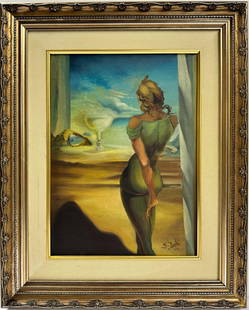
Spanish school of the first half of the XVII century.
Similar Sale History
View More Items in PaintingsRelated Paintings
More Items in Spanish Paintings
View MoreRecommended Art
View More






Item Details
Description
Spanish school of the first half of the XVII century."Nativity.Oil on panel.Size: 27 x 27 cm; 48,5 x 48,5 cm.In this variegated panel, the artist shows the Child Jesus on the ground, completely naked and assisted by little angels. This iconography is based on the Revelations of Saint Bridget of Sweden, from the 14th century, who in one of her visions, includes the description of the moment of childbirth given to her by the Virgin herself. According to this vision, when Mary knelt down to pray, she felt the Child move inside her, whom she immediately gave birth to. Without changing her position, the Virgin began to adore the Child with the utmost decorum and reverence, and was joined shortly afterwards by angels. Meanwhile, St. Joseph had gone out to look for something to light the place and did not attend the birth. Also participating in the scene are the ox and the mule, omnipresent in our traditional Nativity scenes, which, however, are not mentioned in the accounts of the Birth of Christ given in the canonical Gospels.The Gospel of St. Luke tells that St. Joseph and the Virgin Mary went to Bethlehem to register following a census ordered by Rome and adds: "And it came to pass, while they were there, that the days of childbirth were fulfilled, and she gave birth to her firstborn son, wrapped him in swaddling clothes and laid him in a manger, because they had no room in the inn. Some apocryphal gospels, such as the Protoevangelium of James or the Pseudo-Matthew, refer to the place of birth as a grotto or cave, plunged in darkness, a motif that will appear frequently in Byzantine art and is also maintained in traditional nativity scenes. In Western art, on the other hand, the motif of the grotto is rare. Based on accounts such as that of The Golden Legend of Jacobus of Voragine, from the 13th century, the scene is usually located in a stable or shed, as in the present panel, generally in ruins and semi-abandoned, which was used as a shelter or resting place by both people and animals.
Buyer's Premium
- 23%
Spanish school of the first half of the XVII century.
Estimate €1,200 - €1,500
4 bidders are watching this item.
Shipping & Pickup Options
Item located in Barcelona, -, esOffers In-House Shipping
Payment

Related Searches
TOP

















































































